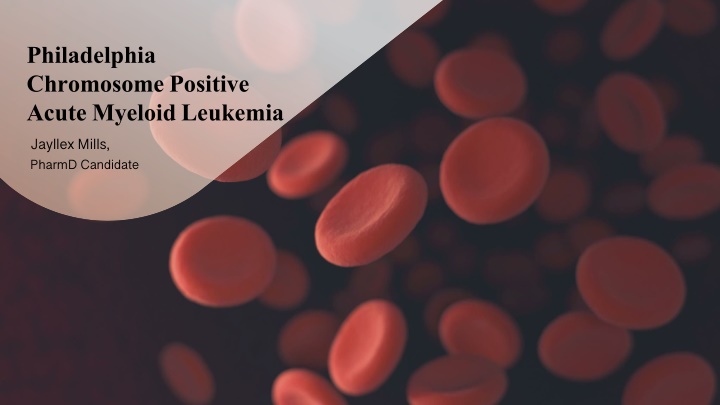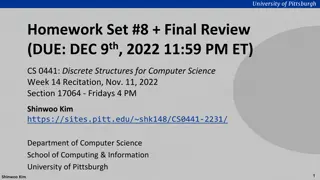
Philadelphia Chromosome Positive Acute Myeloid Leukemia
Learn about the background, typical presentation, genetic mutations, standard of care, and treatment approaches for Philadelphia Chromosome Positive Acute Myeloid Leukemia (AML). Explore the role of the BCR-ABL1 fusion gene, diagnostic testing, and therapy options in managing this hematologic malignancy affecting the blood and bone marrow.
Download Presentation

Please find below an Image/Link to download the presentation.
The content on the website is provided AS IS for your information and personal use only. It may not be sold, licensed, or shared on other websites without obtaining consent from the author. If you encounter any issues during the download, it is possible that the publisher has removed the file from their server.
You are allowed to download the files provided on this website for personal or commercial use, subject to the condition that they are used lawfully. All files are the property of their respective owners.
The content on the website is provided AS IS for your information and personal use only. It may not be sold, licensed, or shared on other websites without obtaining consent from the author.
E N D
Presentation Transcript
Philadelphia Chromosome Positive Acute Myeloid Leukemia Jayllex Mills, PharmD Candidate
AML Background Hematologic malignancy affecting the blood and bone marrow Result of proliferation of abnormal myeloid stem cell derivatives and interference of normal blood cell production Encompasses several different subtypes with various stages of aggression
Typical Presentation Patient presentation Classic B symptoms, increased bleeding/bruising, more susceptible to infection More common in older population Laboratory findings CBC w/ diff Elevated WBCs Blast counts Lactate dehydrogenase (LDH) Correlates to tumor burden Bone marrow core biopsy and aspirate analysis Blast counts Genetic mutation analysis FISH FLT3 PCR
Philadelphia Chromosome Translocation t(9;22) BCR-ABL1 fusion gene Prevalence in subgroups of leukemia: Diagnostic for chronic myeloid leukemia Can be found in acute lymphoblastic leukemia Rare in acute myeloid leukemia
Standard of Care in AML Induction Intensive Alternative (Less-Intensive) Goal of therapy: improve quality of life, restore hematopoiesis Regimen: Azacitidine (or low-dose cytarabine) + venetoclax Goal of therapy: BMBx < 5% blasts First line: 7 + 3 (7 days of cytarabine + 3 days daunorubicin) Consolidation Patients < 60 years old HiDAC (high-dose cytarabine) Consider allogenic HCT Patients > 60 years old Intermediate-dose cytarabine
Standard of Care in Ph+ Patients Most studies focus on CML patients Addition of tyrosine kinase inhibitor likely indicated Select TKI based on patient-specific factors First generation Imatinib chronic fatigue, contraindicated with warfarin Second generation Dasatinib platelet aggregation, pleural effusion Nilotinib QT prolongation, pancreatitis Bosutinib diarrhea, increased ALT/AST Insurance coverage may be difficult to obtain
Ph+ AML Patients on Acute Leukemia Service 36-year-old male 74-year-old male Presented to OSH for fever/fatigue WBC: 140s BMBx: hypercellular with sheets of blasts No PMH Candidate for intensive induction PMH of CHF, CAD s/p PCI, COPD, HTN, HLD, ascending aortic aneurysm Not a candidate for intensive induction
Treatment Selection 36-year-old male 74-year-old male 7 + 3 (+ dasatinib) for intensive therapy Dasatinib started D9 following insurance rejections and co-pay card delays Currently on day 19 of therapy Imatinib monotherapy in the setting of older age and comorbidities Converted to comfort care during insurance appeal
Next Steps Usual lumbar puncture at count recovery on D14 Consolidation once adequate response achieved BCR-ABL1 PCR? Maintenance with TKI? Azacitidine? Allogenic HCT?
Implications for Future Clinical Practice Demonstrates need for clear appeal process for indication Minimize delays in receiving care Continue to look at patient characteristics for TKI selection until data supporting superiority becomes available for this condition
References 1. Pollyea DA;Bixby D;Perl A;Bhatt VR;Altman JK;Appelbaum FR;de Lima M;Fathi AT;Foran JM;Gojo I;Hall AC;Jacoby M;Lancet J;Mannis G;Marcucci G;Martin MG;Mims A;Neff J;Nejati R;Olin R;Percival ME;Prebet T;Przespolewski A;Rao D;Ravandi-Kashani F;Shami PJ;Stone . NCCN guidelines insights: Acute myeloid leukemia, version 2.2021. Journal of the National Comprehensive Cancer Network : JNCCN. Accessed June 27, 2023. https://pubmed.ncbi.nlm.nih.gov/33406488/. 2. Quraishi AM, Akram M, Saeed S, Tahir M. Philadelphia Chromosome Positive de novo Acute Myeloid Leukemia. J Coll Physicians Surg Pak. 2016;26(11):100-102. 3. Bhatt VR, Akhtari M, Bociek RG, et al. Allogeneic stem cell transplantation for Philadelphia chromosome-positive acute myeloid leukemia. J Natl Compr Canc Netw. 2014;12(7):963- 968. doi:10.6004/jnccn.2014.0092. 4. Kondo T, Tasaka T, Sano F, et al. Philadelphia chromosome-positive acute myeloid leukemia (Ph + AML) treated with imatinib mesylate (IM): a report with IM plasma concentration and bcr-abl transcripts. Leuk Res. 2009;33(9):e137-e138. doi:10.1016/j.leukres.2009.03.017. 5. Piedimonte M, Ottone T, Alfonso V, et al. A rare BCR-ABL1 transcript in Philadelphia- positive acute myeloid leukemia: case report and literature review. BMC Cancer. 2019;19(1):50. doi:10.1186/s12885-019-5265-5.
Questions? Jayllex Mills mills.708@osu.edu




















